In Ethiopia, agriculture stands as the cornerstone of both the economy and the daily lives of its people. This sector drives most of the country's income, and the figures are striking. Coffee, often dubbed Ethiopia's 'green gold,' leads the way in exports, offering a glimpse into a rich tradition and an equally promising future.
But coffee is just the beginning. Ethiopia's varied climates and fertile lands mean that farmers here grow an array of crops. From teff to maize and sorghum, these agricultural products are crucial not only for sustenance but also for the economy.
More than 70% of Ethiopia's population works in agriculture. This isn't just about providing food; it's about livelihoods and communities. Smallholder farms dominate the landscape, blending traditional methods with increasingly modern techniques.
However, this reliance on agriculture isn't without its challenges. Issues like climate change, lack of infrastructure, and market access pose significant hurdles. Still, there are ample opportunities for growth and improvement. Exploring Ethiopia's agricultural backbone reveals a complex tapestry of challenges and prospects, shaping the future of this resilient nation.
- Agricultural Backbone
- Coffee: Ethiopia's Green Gold
- Diverse Crop Production
- Employment and Livelihoods
- Challenges and Future Prospects
Agricultural Backbone
When we talk about Ethiopia's economy, agriculture stands tall as its backbone. This sector forms the very foundation upon which the country builds its financial strengths and sustains its populace. Firstly, it's essential to note that agriculture in Ethiopia isn't just about feeding the masses; it contributes to more than 40% of the GDP. This broad spectrum encompasses crops, livestock, forestry, and fisheries, forming an intricate web of interdependent industries that help nourish one of Africa’s most populous countries.
The serene beauty of Ethiopia's highlands and the vast expanses of its lowlands offer diverse climates, making it an agricultural treasure trove. The highlands are often wrapped in a mist that ensures the soil is fertile, while the lowlands boast warm temperatures ideal for growing various crops. This climatic diversity is why you see a unique array of crops being cultivated, from teff in the north to maize in the east.
Teff, a staple in Ethiopian diets, is used to make injera, a flatbread that is central to Ethiopian cuisine. It is not only culturally significant but also nutritionally rich, offering a high content of calcium, iron, and protein. In fact, Ethiopia is the world's largest producer of teff, making it an integral part of both the local diet and the economy.
The agricultural sector isn’t merely confined to plant cultivation; it also includes significant livestock production. Ethiopia has one of the largest livestock populations in Africa, with millions of cattle, sheep, and goats grazing its fields. This animal farming provides essential dairy products, meat, and hides contributing substantially to the country's economic activities and exports.
An interesting aspect lies in the methods employed by Ethiopian farmers. For generations, smallholder farms, which average less than a hectare in size, have thrived using traditional farming techniques. It’s a blend of old and new, where farmers often integrate modern agricultural technology with age-old practices. This blend ensures that the farming remains sustainable and productive, keeping the soil fertile and the yields ample.
However, despite its importance and contributions, the agricultural backbone faces numerous challenges. Climate change is a looming threat, with increasing instances of droughts and unpredictable rainfall patterns affecting crop yields and livestock health. Additionally, limited access to improved seeds, fertilizers, and modern farming equipment hampers productivity for many small-scale farmers. Infrastructure issues also make it difficult to market and export produce effectively, impacting both farmers' incomes and the national economy.
Efforts to mitigate these challenges are underway. Investments in irrigation projects, improved agricultural practices, and better access to markets are part of the strategies to enhance productivity. Notable organizations and NGOs are working closely with local farmers to provide training and resources, ensuring that the agricultural sector doesn't just survive but thrives.
As Former Prime Minister Hailemariam Desalegn once said in an interview with the Ethiopian Herald,
Agriculture is not just the backbone; it’s the heart and soul of our economy. By investing in it, we invest in the future of our nation and well-being of our people.
In conclusion, Ethiopia's agricultural backbone is a nuanced and multi-layered sector rich with tradition, modern practices, and an array of challenges and opportunities. By understanding its intricacies and working towards sustainable agricultural practices, Ethiopia continues to stride towards a promising and prosperous future.
Coffee: Ethiopia's Green Gold
The story of Ethiopian coffee begins deep in the rich, fertile lands of the country's highlands. Ethiopia is often touted as the birthplace of coffee, with tales of Kaldi, a young goat herder, who discovered the energizing effects of the coffee bean over a thousand years ago. Today, coffee remains Ethiopia's most valuable export, weaving a crucial thread through its cultural and economic fabric.
What makes Ethiopian coffee truly special is its incredible diversity. The nation boasts some of the world's most distinct coffee varieties. There's Yirgacheffe with its floral notes, Sidamo known for its complexity, and Harar which offers a fruity, almost wine-like flavor. Such variety is no accident; Ethiopia's unique climates and terrains provide an ideal environment for the coffee plant to thrive. As a result, Ethiopian coffee is often sought after for both its quality and character.
The cultivation and processing of coffee in Ethiopia often blend tradition with innovation. Smallholder farms dominate the landscape, with farmers practicing methods passed down through generations. These farms might be small, often less than a hectare, but they are incredibly productive. Coffee is typically shade-grown, which means it develops slowly, ultimately enhancing its flavor profile. Traditional processing methods like the dry and wet processing are still widespread, each contributing to the distinct taste.
Ethiopian coffee's journey from plantation to cup isn't just a tale of agricultural prowess. It’s also a source of income for over 15 million Ethiopians. In rural areas, entire communities depend on coffee production for their livelihoods. This makes the coffee industry not just an economic powerhouse but also a social cornerstone, supporting schools, healthcare, and infrastructure in coffee-growing regions.
However, the coffee sector isn't without its challenges. Farmers often face issues like fluctuating market prices and the looming threat of climate change. These factors can significantly affect yield and quality, putting their primary source of income at risk. Despite these challenges, the resilience of the Ethiopian coffee farmer remains palpable. Investments in modern agricultural techniques and fair trade practices are helping to bolster this vital industry.
One cannot discuss Ethiopian coffee without mentioning its intricate role in the country's social life. Coffee ceremonies are an integral part of Ethiopian culture, often used to welcome guests, mark special occasions, or simply bring communities together. These ceremonies are a testament to the deep-rooted connection between the Ethiopian people and their beloved coffee plant.
"Ethiopian coffee isn't merely a drink; it's a cultural heritage," says Tadesse Meskela, General Manager of the Oromia Coffee Farmers Cooperative Union.
"Every cup tells the story of the land, the farmers, and the traditions that have nurtured it for centuries."
This profound cultural and economic impact of coffee underscores its status as Ethiopia’s 'green gold.' From its ancient origins to modern-day significance, coffee continues to shape the narrative of Ethiopia's journey. Whether you're a coffee enthusiast or curious about global agricultural systems, understanding Ethiopian coffee offers a deeper appreciation for this remarkable bean and the incredible country it calls home.
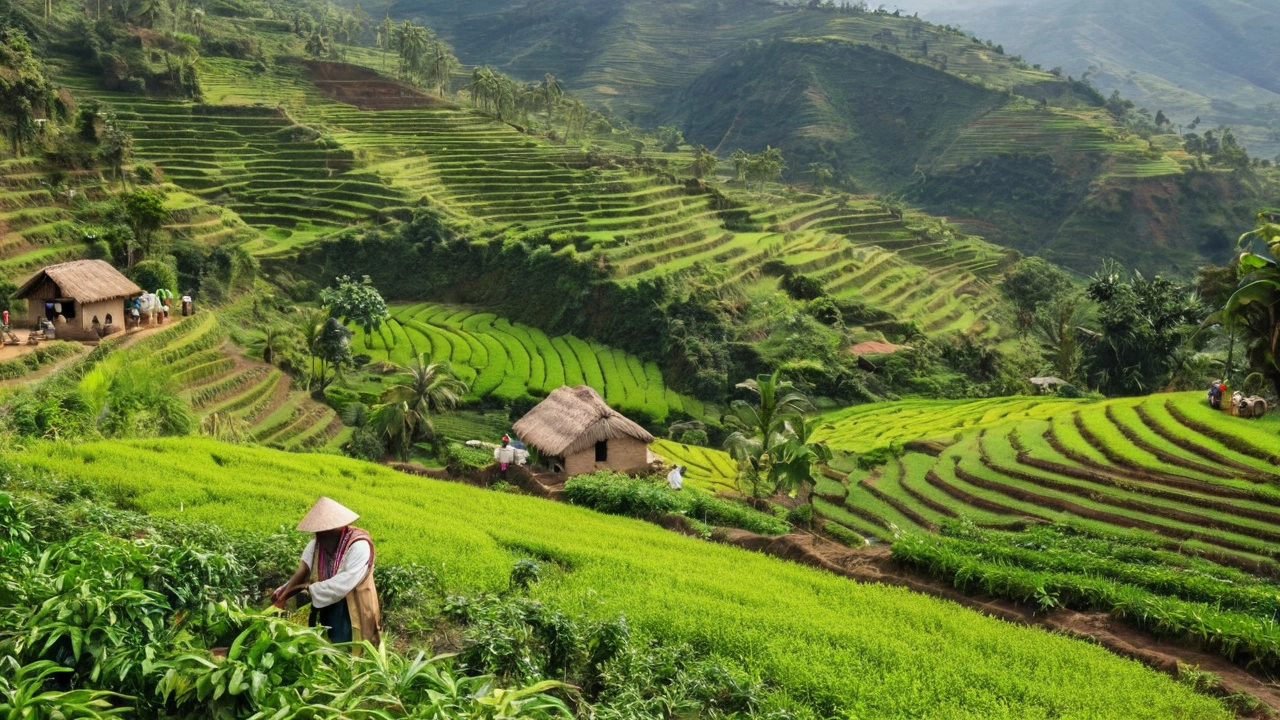
Diverse Crop Production
One of the standout features of Ethiopia's agriculture is its diverse crop production. The country's varying elevations and climates mean that a wide range of crops can be cultivated. From the highlands to the lowlands, the soil and weather conditions support the growth of numerous essential agricultural products.
A staple food that holds great cultural and economic significance is teff. This small grain is crucial in Ethiopian cuisine, forming the basis for the national dish, injera. Teff is incredibly resilient, able to grow in various climates, which makes it a dependable crop for farmers across the country. Additionally, its nutritional value has gained international interest, boosting its export potential.
Maize is another vital crop for Ethiopia, providing a primary food source for many rural families. The ability of maize to thrive in different regions makes it an essential component of food security. Farmers often employ traditional methods alongside modern practices to maximize their yield, ensuring maize remains a consistent part of the agricultural landscape.
Coffee, as previously mentioned, is Ethiopia's ‘green gold.’ But the country's agricultural diversity doesn't stop there. Sorghum, barley, and wheat are also widely cultivated. These grains are fundamental to the diet and livelihoods of millions. Each crop has its own unique growing requirements and regional preferences, which speaks volumes about Ethiopia's diverse agricultural potential.
Horticulture is another flourishing sector. Ethiopian flowers, especially roses, are in high demand globally, contributing significant revenue to the economy. The country's unique conditions allow for year-round production of high-quality flowers, making it a prominent player in the international flower trade.
Beyond grains and flowers, Ethiopia is also rich in fruits and vegetables. Spices like ginger and turmeric are grown, benefiting from the country's fertile soils. These spices are not only used locally but are also exported, contributing to the global market.
According to a report by the United Nations Food and Agriculture Organization,
Employment and Livelihoods
Employment in Ethiopia is heavily tied to the agricultural sector, which employs more than 70% of the population. This sector is the bedrock of both urban and rural communities, weaving a critical thread through the social and economic fabric. Approximately 80% of Ethiopians are involved in subsistence farming, where family-run plots dominate the landscape. Smallholder farmers produce the majority of the country's staples, including teff, coffee, maize, and sorghum. In regions with fertile soil, agricultural activities often extend beyond mere survival, playing a key role in local economies and societies.
Small farms are not just about producing crops, though. They are microcosms of everyday Ethiopian life, where agricultural work intertwines with cultural traditions and family bonds. The typical Ethiopian farmer relies on age-old techniques received from ancestors, yet is increasingly integrating modern methods and technology to improve yields and efficiency. Irrigation improvements, better quality seeds, and farming equipment are making a mark, slowly but steadily.
One interesting fact is the role of women in Ethiopian agriculture. Women constitute around 60% of the labor force in this sector. Yet, they often face hurdles such as limited access to land, credit, and technology. Allowing women better opportunities and resources could be a transformative step for the Ethiopian economy. According to a report from the United Nations, "Enhancing women's access to agricultural resources could increase farm productivity by 20-30%, thereby lifting millions out of poverty."
Challenges are present, no doubt. Factors like climate change, fluctuating market prices, and poor infrastructure pose threats to stable income. Many rural families live at the mercy of unpredictable weather patterns, leading to potential crop failures that could devastate their financial stability. In more remote areas, lack of access to markets forces farmers to sell their products at lower rates or simply consume what they produce, limiting economic growth.
Despite these challenges, there's a growing trend towards cooperative farming and community-driven agricultural projects. Such initiatives aim to pool resources, share knowledge, and improve collective bargaining power. The government's involvement through initiatives like the Agricultural Transformation Agency also brings hope. By focusing on systemic change and innovation, these programs aim to create a more sustainable agricultural economy that benefits all participants.
Another notable aspect is the younger generation's contribution to agriculture. Increasingly, young people are combining traditional knowledge with modern innovations, such as mobile apps that help predict weather patterns or drones for surveying land. This blend of old and new is creating a dynamic environment where the potential for growth and improvement remains high.
As agriculture continues to form the backbone of Ethiopia's economy, the interplay of family farms, women’s roles, challenges, and innovations paints a comprehensive picture of a vibrant sector. Improving employment and livelihood opportunities in agriculture will play a crucial role in the country's journey towards economic stability and growth.
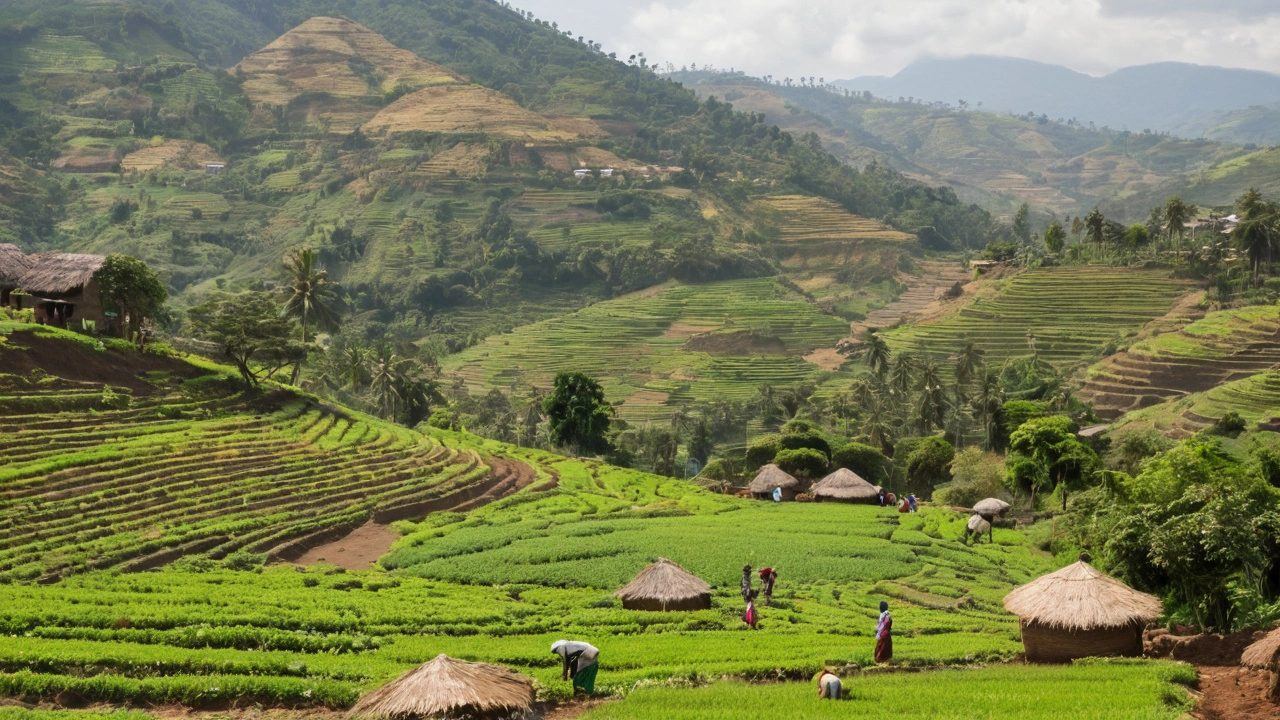
Challenges and Future Prospects
Agriculture is the backbone of Ethiopia's economy, but it faces numerous challenges that must be addressed to secure a prosperous future. One of the biggest hurdles is climate change. Unpredictable weather patterns, prolonged droughts, and irregular rainfall can severely impact crop yields. These climate-related issues not only threaten the food supply but also the livelihoods of millions who depend on farming.
Another significant challenge is the lack of infrastructure. Many rural areas in Ethiopia lack access to good roads, reliable transportation, and storage facilities. This makes it difficult for farmers to get their products to market in good condition. A lot of produce spoils before it even has the chance to be sold. Investments in infrastructure could greatly improve the efficiency of the agricultural sector and reduce waste.
Access to financing is another bottleneck. Many smallholder farmers lack the financial resources to invest in necessary tools, seeds, and fertilizers. Without these inputs, it is hard for them to increase productivity. Microfinance initiatives and government subsidies could provide the support needed to boost agricultural output and income.
Market access also presents a challenge. Ethiopian farmers often struggle to find markets for their products, both domestically and internationally. Complex and inefficient supply chains, coupled with limited market information, hinder their ability to sell at competitive prices. Building stronger market linkages and providing better market information could help farmers get better returns for their produce.
Despite these challenges, there are promising opportunities on the horizon. Technological advancements in agriculture offer new ways to enhance productivity and sustainability. Mobile technologies can provide farmers with weather updates, crop management tips, and market prices in real time. Improved irrigation techniques and drought-resistant crop varieties can mitigate some of the impacts of climate change.
Elias Melaku, a noted Ethiopian agronomist, has noted, "The key to the future of Ethiopia's agriculture lies in the integration of modern technology with traditional farming practices. We have to harness the best of both worlds."NGOs and international organizations are also stepping in to provide support and drive capacity-building efforts. Projects focusing on farmer education, sustainable practices, and cooperative farming are on the rise, aiming to uplift entire communities. Additionally, there is a growing interest in organic farming and fair trade practices, which can open new markets and provide higher income for Ethiopian farmers.
There is certainly room for optimism. With the right mix of innovation, investment, and strategic planning, Ethiopia could transform its agricultural sector and secure a more stable and prosperous future. The road ahead may be challenging, but the potential rewards make the journey well worth the effort. By addressing these obstacles head-on and harnessing available opportunities, Ethiopia can truly realize the promise of its agricultural heritage.
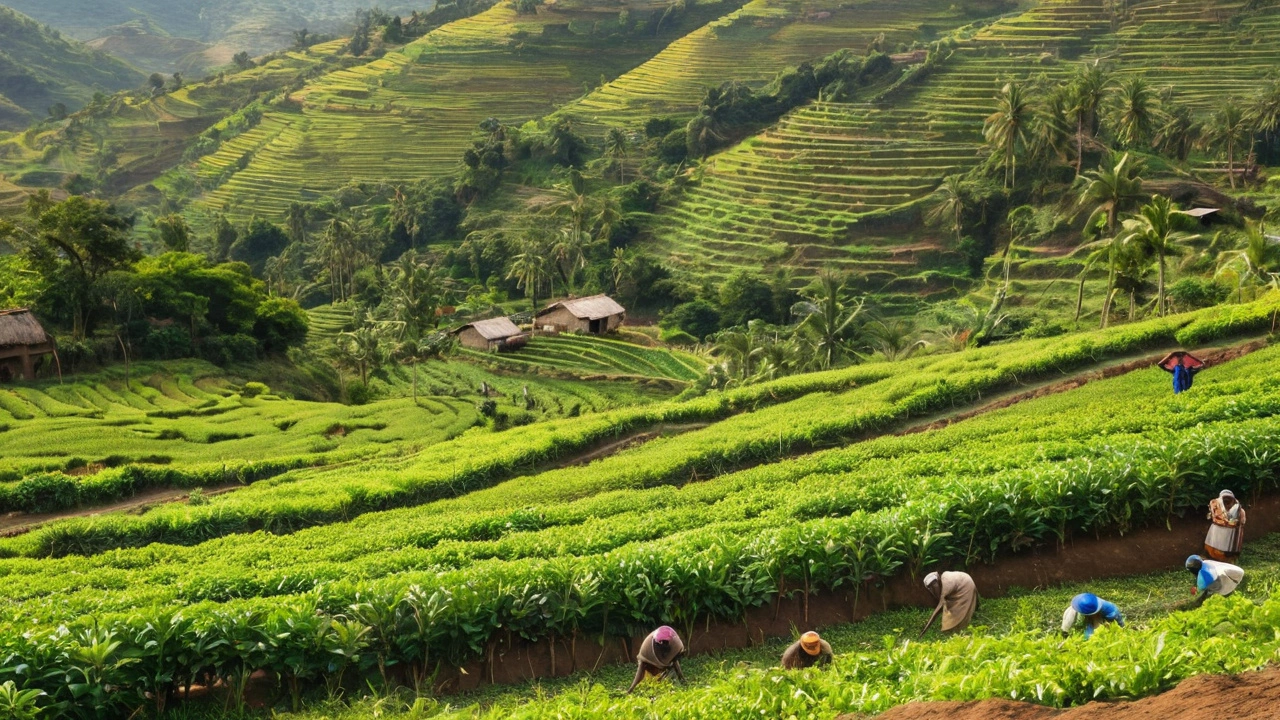
 Best Business Opportunities in Ethiopia for 2024
Best Business Opportunities in Ethiopia for 2024
 Discovering Ethiopia's Wealth: Natural and Cultural Riches Revealed
Discovering Ethiopia's Wealth: Natural and Cultural Riches Revealed
 Understanding Taxation in Ethiopia: Do Ethiopians Pay Taxes?
Understanding Taxation in Ethiopia: Do Ethiopians Pay Taxes?
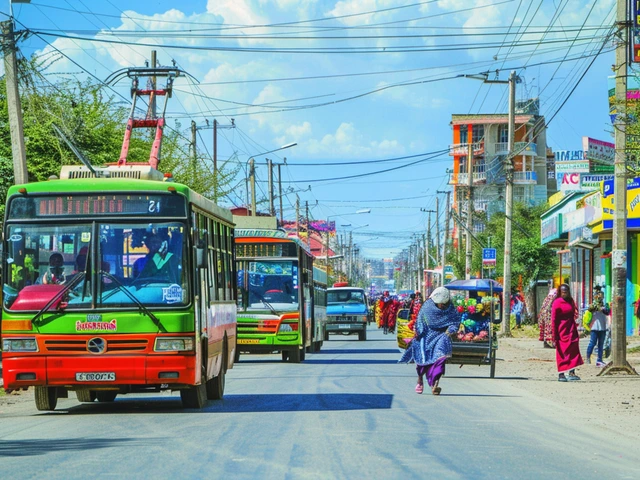 Priorities for Ethiopia's Development: Key Needs and Insights
Priorities for Ethiopia's Development: Key Needs and Insights
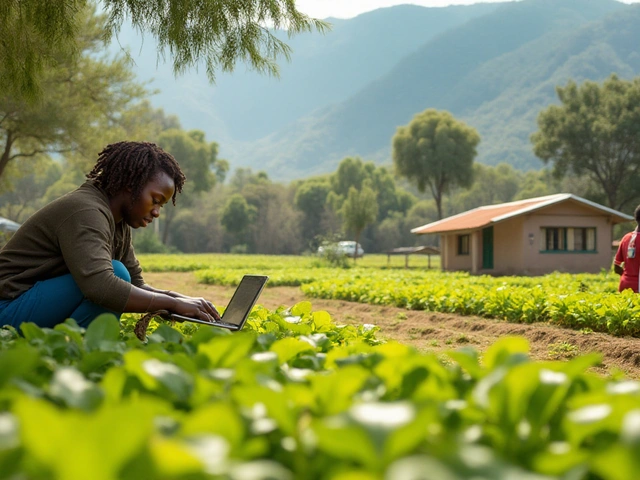 Exploring Common Occupations in Ethiopia: Agriculture, Technology, and Beyond
Exploring Common Occupations in Ethiopia: Agriculture, Technology, and Beyond
randy mcgrath
August 5, 2024 AT 17:34Ethiopia's farms truly stitch the nation together.
Frankie Mobley
August 9, 2024 AT 04:54Coffee is Ethiopia's biggest export, often called the country's green gold. The beans come from high‑altitude regions like Yirgacheffe, Sidamo and Harar, each with a distinct flavor profile. Smallholder farmers grow most of the coffee, usually on plots under a hectare, and the trade supports millions of families. Export revenues from coffee account for roughly 30 % of Ethiopia’s foreign earnings, making it a critical pillar of the economy. Investing in quality control and fair‑trade certification helps both growers and buyers.
ashli john
August 12, 2024 AT 16:14What a rich story of the land and its people. The diversity of crops shows real resilience. Every farmer adds a piece to the national tapestry. Keep the hope alive you all are doing amazing work.
Kim Chase
August 16, 2024 AT 03:34I definately think the article missed the point about the agri‑culture education need. Many farms still lack basic tools like proper irriagation and seed variety access. This is why local coopertives are so important.
David Werner
August 19, 2024 AT 14:54Behind the rosy narrative of Ethiopia’s coffee lies a shadow network of multinational interests pulling the strings. Every cup that reaches our tables is a reminder of how foreign capital infiltrates rural livelihoods, steering production toward profit rather than people. The climate crises are not just natural-they’re engineered through secret deals that deprive farmers of water rights. When the government talks about “investment,” it’s really a handoff of sovereign land to corporate estates that will reap the bulk of the harvest while the original growers are left with crumbs.
Paul KEIL
August 23, 2024 AT 02:14The discourse invoked herein exemplifies a systemic agronomic externality framework wherein geopolitical capital reconfigures endemic agro‑ecological niches. Such a paradigm shift necessitates a lexicon of bioprospective governance and post‑colonial market realignment.
Horace Wormely
August 26, 2024 AT 13:34The article states “More than 70% of Ethiopia’s population works in agriculture.” Grammatically the verb should agree with the plural subject, so it ought to read “More than 70% of Ethiopia’s population work in agriculture.”
christine mae cotejo
August 30, 2024 AT 00:54The agricultural tapestry of Ethiopia is woven from centuries of indigenous knowledge and recent technological infusion.
From the mist‑clad highlands where teff thrives to the sun‑baked lowlands nurturing maize, each ecological zone contributes a distinct thread to the national fabric.
Coffee, the legendary "green gold," not only fuels export revenues but also anchors cultural rituals that bind communities together in daily ceremonies.
Teff, often overlooked on the global stage, supplies a staple that sustains more than half of the population, delivering essential micronutrients such as iron and calcium.
Livestock, numbering in the tens of millions, provide dairy, meat, and draught power, reinforcing food security and agricultural productivity.
Yet, the sector grapples with erratic rainfall patterns that have intensified over the past decade, jeopardizing both crop yields and pastoral health.
Infrastructure deficits, particularly in rural road networks and storage facilities, cause post‑harvest losses that can exceed twenty percent of total production.
Access to quality inputs-improved seed varieties, balanced fertilization, and modern mechanization-remains uneven, disproportionately affecting smallholder farms.
Women, who represent roughly sixty percent of the agricultural labor force, frequently encounter barriers to land ownership and credit, limiting their capacity to innovate.
Governmental initiatives, such as the Agricultural Transformation Agency, aim to address these gaps through irrigation projects and market‑linkage programs.
Non‑governmental organizations complement these efforts by delivering training on climate‑smart farming practices, including conservation agriculture and agroforestry.
The rise of mobile technology has empowered farmers with real‑time weather forecasts, price signals, and digital extension services, fostering more informed decision‑making.
Export diversification beyond coffee-into horticulture, floriculture, and high‑value spices-offers promising avenues for income growth.
Nevertheless, the specter of global commodity volatility looms large, threatening to destabilize income streams for those already vulnerable.
A holistic approach that integrates sustainable resource management, gender equity, and infrastructural investment is essential for converting Ethiopia’s agricultural potential into resilient prosperity.
In this intricate dance between tradition and innovation, the future of Ethiopia’s backbone rests on the collective will of its farmers, policymakers, and partners worldwide.
Douglas Gnesda
September 2, 2024 AT 12:14Excellent synthesis! From a systems‑agronomic perspective, the integration of precision irrigation, genotype‑by‑environment interaction models, and value‑chain analytics will catalyze yield gains while preserving ecosystem services. Leveraging GIS‑based land suitability mapping alongside market‑price forecasting algorithms can optimize input allocation and reduce post‑harvest loss. Moreover, fostering inclusive financing mechanisms-such as blended capital structures that combine development grants with impact‑investment debt-will unlock the capital needed for smallholder scale‑up. Your emphasis on gender‑responsive policies aligns with recent FAO frameworks, underscoring the necessity of women‑centered extension delivery to achieve equitable productivity boosts.
Abhijit Pimpale
September 5, 2024 AT 23:34The post conflates GDP contribution with export earnings; coffee alone accounts for around 30 % of foreign exchange, not the majority of GDP.
Eric DE FONDAUMIERE
September 9, 2024 AT 10:54Yea thats right! Actually the numbers are even more crazy when u look at the per‑capita stats – farmers make only a few bucks a month but still keep the whole system goiing!
Pauline Herrin
September 12, 2024 AT 22:14While the overview captures many salient points, it neglects a rigorous analysis of policy efficacy, particularly regarding the Agricultural Transformation Agency’s measurable outcomes.